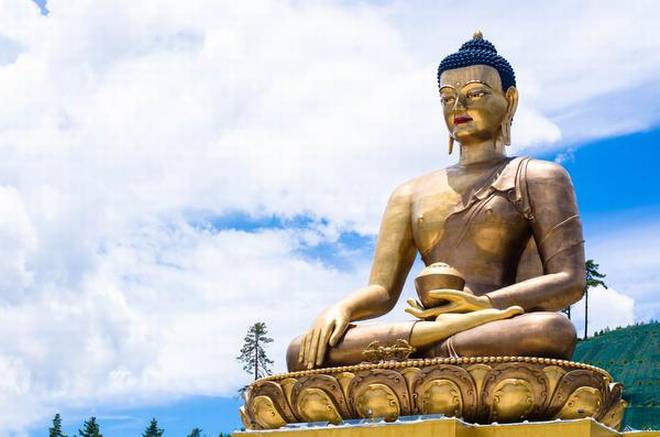Snapshots from the mountain kingdom that has enjoyed a special relationship with India over these past 50 years
At first glance, Thimphu, the capital of the Himalayan kingdom of Bhutan, has an air of sincerity about it. It is an earnest place, with law-abiding, good-natured, unhurried, smiling souls. The cynicism of old-turned-modern cities is absent here. But, the streets of Thimphu are like the streets of any modern city in the world. The roads are clean, and pedestrian-friendly. The pavements are lined with droopy Bhutan cypress trees and upright sunflowers. There is traffic signage everywhere, and zebra crossings occur frequently. No traffic lights, only vigilant policemen. Rumour has it that they installed a traffic light on one of their busiest junctions some years ago. It lasted for about 24 hours, and was soon replaced by a now-famous traffic policeman in white gloves. Apparently, the Bhutanese prefer some things to stay old-school. There are so many traditional buildings here with multi-coloured wood frontages, small arched windows, and sloping roofs, all with motifs and paintings.
In a happy State It is easy to feel good in this Himalayan Kingdom with its monks, prayer flags, bursts of colour and spectacular scenery
In a happy State It is easy to feel good in this Himalayan Kingdom with its monks, prayer flags, bursts of colour and spectacular scenery | Photo Credit: Getty Images
I visit the Voluntary Artists’ Studio, Thimphu (VAST), an innocuous little structure close to the handicrafts market on the banks of Thimphu river. It is an important non-profit institution set up in 1998, where budding Bhutanese artists get together, collaborate, create and display their work. It is buzzing with activity. The garden area outside the studio is littered with plastic bottles and wires, waiting to be transformed into something artistic no doubt. An installation made entirely with bottle caps is already on display. A couple of artists are immersed in making a life-sized turtle from used copper wires. Inside the studio, a young photographer documents paintings created for Bhutan Week in New Delhi.
I cross the ‘busiest junction of Thimphu’, turn the corner and reach Junction Bookstore. It is a cosy, sepia-toned space on two levels. There is a wall devoted to polaroid shots of famous writers. A string of portrait sketches hangs in front of a bookshelf, framed by fairy lights. Origami pieces made from yellowed pages of old books are stuck on walls. Parts of the ceiling and doors are covered with pages torn from old books. Every corner of this space feels like a labour of love. It is gloriously messy. “My father owned this space and gave it to me. I run it purely on passion,” says Mui, founder-manager of the store, and an avid reader herself.
How to get there Places to stay
Drukair and Bhutan Airlines have regular flights from Delhi, Gaya, and Kolkata to Paro. Cabs run regularly from Paro to Thimphu.
One can get a cab from Bagdogra, West Bengal, to the border town of Phuntsholing, and then on to Thimphu.
Thimphu has a number of hotels and guest houses. Depending on your budget, it is best to stay near the Clock Tower, as it has easy access to transport and markets in the city.
It is so easy to spend hours in this little piece of heaven and I do so and then head to Mojo Park, a popular dive bar open till the wee hours. It is a place where people unwind and where the growing tribe of musicians perform. Among those making waves are young rappers Mayina Dubee OG and Kezang Dorji, whose music talks about social issues, Kinley Phyntso, a rock musician, and Dawa Drakpa, who started a band called The Baby Boomers, inspired by The Beatles.
Iron hanging bridge across a fast streaming river in Thimpu
Iron hanging bridge across a fast streaming river in Thimpu | Photo Credit: Getty Images/iStockphoto
As I walk around, I notice how many stray dogs there are on the streets. They lie about, lazing and sleeping during the day and I am cautioned that they do not like you patting them. But they come alive in the evenings when they get active and set up a chorus of barking that can sometimes last all night. Several hotels in Thimphu actually provide earplugs to their guests. “What can we do, they love to bark!” shrugs one hotel manager.
Kunzang Choden, author of the transcendental Dawa: The Story of a Stray Dog in Bhutan, best described the relationship between the Bhutanese folk and stray dogs. She says, “The Bhutanese have a complex relationship with dogs. We have a great many stray and sick dogs here, and yet if there is a programme to neutralise them, we protect them by hiding and feeding them.”
Group of dancers in traditional Bhutanese clothing and masks at the Dechenphodrang Lhakhang monestary
Group of dancers in traditional Bhutanese clothing and masks at the Dechenphodrang Lhakhang monestary | Photo Credit: Getty Images
“We live in a country that is struggling like any other,” says a young Bhutanese when asked about the famous happiness quotient of Bhutan. Journalist Madeline Drexler, in her book A Splendid Isolation: Lessons on Happiness from the Kingdom of Bhutan, remarks, “The Bhutanese have not necessarily found the answers, but they are asking original questions.”








